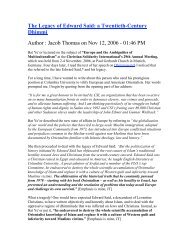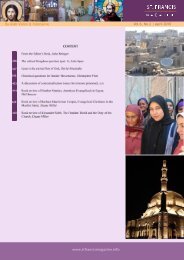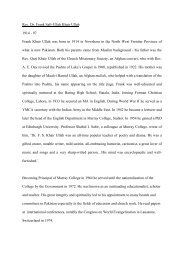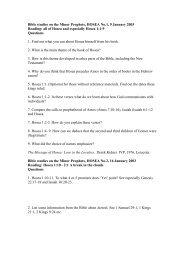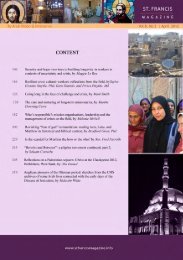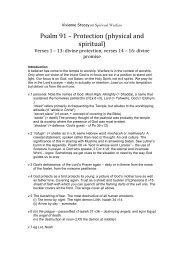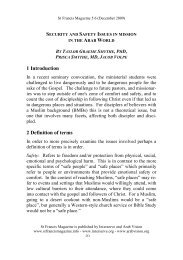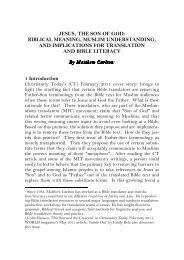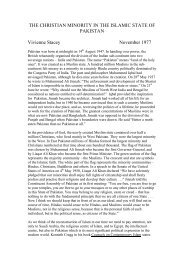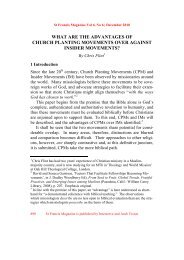download the pdf - St.Francis Magazine
download the pdf - St.Francis Magazine
download the pdf - St.Francis Magazine
Create successful ePaper yourself
Turn your PDF publications into a flip-book with our unique Google optimized e-Paper software.
<strong>St</strong> <strong>Francis</strong> <strong>Magazine</strong> Vol 8, No 4 | August 2012<br />
This site is called Throne of Jamshid (Takht-e Jamshid). The fourth<br />
king, Jamshid, improved civilization. Forbis quotes from Ferdowsi’s<br />
Shahnama:<br />
With <strong>the</strong> aid of <strong>the</strong> royal Farr, he fashioned a marvelous throne, which<br />
at his bidding was lifted by demons into <strong>the</strong> air. He sat upon that<br />
throne like <strong>the</strong> sun in <strong>the</strong> firmament. To celebrate, that day was called<br />
a new day—<strong>the</strong> festival of Now-Ruz—<strong>the</strong> first day of <strong>the</strong> new year<br />
(Forbis 1981, 23).<br />
Forbis suggests that <strong>the</strong> tales of <strong>the</strong>se mythical kings with <strong>the</strong>ir<br />
heroic deeds and tragic failings, along with <strong>the</strong> Zoroastrian history<br />
of Persepolis, melded in <strong>the</strong> creative consciousness of <strong>the</strong> Persian<br />
people. An often repeated <strong>the</strong>me of Iran’s heroic tales is vengeance<br />
for <strong>the</strong> unjust death of an Iranian king or warrior.<br />
In attempting to understand <strong>the</strong> revolution of 1978-79, it helps, I think,<br />
to know something of <strong>the</strong> heritage of heroic mythology that may have<br />
been, subconsciously or not, on <strong>the</strong> minds of those rioters in <strong>the</strong> streets<br />
(Forbis 1981, 22).<br />
The Zoroastrian understanding of vengeance for <strong>the</strong> unjust<br />
death of <strong>the</strong> Iranian king is one element that shapes <strong>the</strong> Iranian perception<br />
and reaction to injustice.<br />
The newly formed religion of Muhammad exploded into <strong>the</strong> Persian<br />
Empire under <strong>the</strong> expansionist rightly guided caliph, Umar.<br />
Persia and Byzantium were conquered by 652 A.D. At first <strong>the</strong> Arabs<br />
did not press <strong>the</strong> Persians to become Muslims, but under <strong>the</strong><br />
heavy hand of <strong>the</strong> poll tax (jizyah) used to subjugate non-Muslims,<br />
based upon Qur’anic Surah 9:29, Iranian Persians adopted Islam to<br />
escape <strong>the</strong> poll tax levied on infidels (Forbis 1981, 31). Persian culture<br />
and its centers of learning influenced <strong>the</strong> Islamic Empire into<br />
its golden age (750-1258 AD) (Mackey 1996, 41).<br />
Iranians eventually converted to Shi’ism as an integral part of<br />
Iranian identity because it spoke to Persian culture and <strong>the</strong> Iranian<br />
experience. Shi’ism, like Sunni Islam, shares common beliefs in <strong>the</strong><br />
Oneness of God, <strong>the</strong> prophethood of Muhammad, and <strong>the</strong> belief in<br />
<strong>the</strong> resurrection. To this Shi'ite belief were added two o<strong>the</strong>rs during<br />
<strong>the</strong> lifetime of Imam Jaafar Ibn Muhammad (702-765 AD):<br />
<strong>St</strong> <strong>Francis</strong> <strong>Magazine</strong> is a publication of Interserve and Arab Vision 405




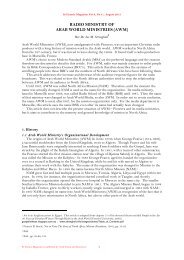
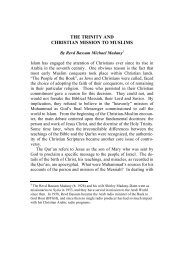
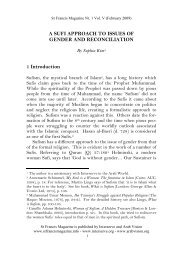
![Reflections on Surah Fatiha and the Lord's Prayer[1] - St.Francis ...](https://img.yumpu.com/49377951/1/184x260/reflections-on-surah-fatiha-and-the-lords-prayer1-stfrancis-.jpg?quality=85)
